
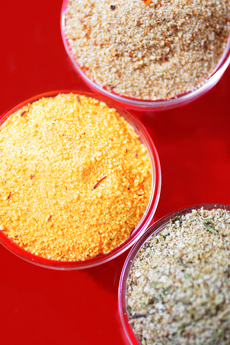
Flavored sea salt from Ritrovo. Photo by Naheed Choudhry | THE NIBBLE.
September 2005
Last Updated June 2018
|
 |
Culinary Salt Glossary
Page 7: Sea Salt & Other Salt Terms Terms Beginning With Letters S ~ V
This is Page 7 of a 7-page glossary. Some of the terms below include sea salt, smoked salt and sodium. After you’ve read up on sea salt, take a look at our other food glossaries—an easy way to get up to speed on many different food categories.
Click on a letter to go to the appropriate glossary page.
a b c d e f g h i j k l m n o p q r s t u v w x y z
This glossary is protected by copyright and cannot be copied or
reproduced in whole or in part.
SALT
A chemical compound, sodium chloride, that can be mined from the ground or harvested from the sea. Today most salt is mined from large deposits that have remained from dried salt lakes. It is a commonly used flavoring used to enhance and add a distinctive seasoning to a variety of foods. Salt is also used as a preservative to enable foods to be stored for longer periods of time without spoiling. Salt is available in several forms, such as table salt, citric salt, fleur de sel, kosher salt, iodized salt, pickling salt, sea salt, seasoned salt, sel gris, and rock salt. The different types vary in composition, texture or grain (granular, fine grain, crystalline, flaked), and usage.
SALT-FREE
Having less than 5 mg of sodium per serving. See also low salt and very low salt.
SAUNIER
A salt worker or salt seller. Saunier refers to anyone who works in the salt industry. The people who rake the salt with poles are called paludiers.
SEA SALT or SEL DE MER or SALE MARINO or BAY SALT
A broad term that generally refers to unrefined or minimally refined salt, containing trace minerals and naturally evaporated from a living ocean, sea or bay. It is harvested by channeling ocean water into large clay trays and allowing the sun and wind to evaporate it naturally. Some of the most common sources for sea salt are the Mediterranean Sea, the North Sea, and the Atlantic Ocean, particularly in France on the coast of Brittany.
|
|
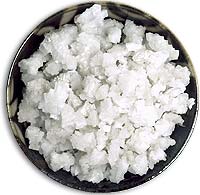
Bali smoked sea salt. Photo courtesy SaltWorks.us. |
Manufacturers of sea salt typically do not refine sea salt as much as other kinds of salt, so it still contains traces of other minerals, including iron, magnesium, calcium, potassium, manganese, zinc and iodine. Proponents of sea salt favor about its bright, pure, clean flavor, and the subtleties provided by the trace minerals. The salt is generally available in a variety of grain sizes. Examples include fleur de sel and sel gris. Sea salt is not recommended for canning or pickling.
SEASONED SALT
A salt that has a base of regular salt along flavored with other seasonings such as dry mustard, garlic powder, onion powder and paprika. The term also refers to a salt that is combined with only one other seasoning, such as onion salt or garlic salt.
SEL DE MER
Evaporated Mediterranean Sea water (photo at left). It contains trace minerals and nutrients that are not found in refined salt. It is generally available in fine and coarse grinds. |
|
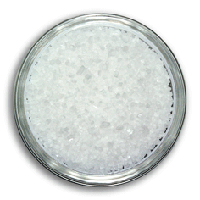
Coarse-ground sel de mer. Photo courtesy SaltWorks.us. |
SEL GRIS or CELTIC SALT or GREY SALT or SEL MARIN
A type of natural sea salt, in English translation grey salt, that is harvested from the Atlantic waters from the coastal area of the Guèrande, Brittany region of France, off the west-central coast of France. It is hand-harvested by paludiers who continually rake the salt beds. They use the Celtic method of wooden rakes, allowing no metal to touch the salt; thus these also are called Celtic salts. Colored light grey by the chemical deposits of the minerals in the salt beds, this salt is harvested as the water evaporates from moist basins, leaving the crusty saline as residue.
|
|
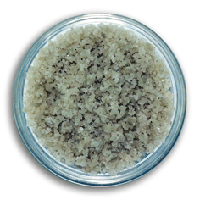
Coarse sel gris. Photo courtesy SaltWorks.us. |
Naturally moist grey salt is an unrefined form of salt sought for it purity and flavor which comes from its rich mineral content. It has a sharper, bolder flavor than Fleur de Sel and is an excellent cooking salt. Use it to bake bread or on roasted cuts of meat. The town of Guérande and the nearby islands of Noirmoutier and Re’ have the only remaining, traditionally-harvested salt marshes in France. Salt sold in the three locations are labeled with the name of origin, so salt from Noirmoutier is called Sel Marin de Noirmoutier and salt from Guérande is called Sel Marin de Guérande. The salt is otherwise the same. See also paludier and polder.
SELMELIER
A selmelier is a trained and knowledgeable professional specializing in culinary salt and its use in cooking and restaurant service. Coined by food writer Mark Bitterman, the term was meant to be analog to sommelier, a wine expert who makes recommendations. Sel is the French word for salt. A selmelier can consult with chefs on the best pairings of foods and salts. Some restaurants may offer diners a choice of salts, with recommendations from the selmelier.
|
SMOKED SALT
A relatively new category of gourmet salts, which can be naturally smoked over wood fires to infuse the salt crystals with natural smoke flavor, or be artificially infused. Smoked salts add a smoke house flavor to a wide range of dishes including roasts, chicken and grilled meats, salmon, soups, salads and sandwiches, steamed vegetables, on corn, egg dishes, on baked potatoes, as a dry rub. Interesting in color, sprinkle as a decorating garnish—or use as a glass rimmer on a Bloody Mary. Examples include alder smoked salt (below, right) and tropical sea salts that have been smoked over coconut shells and kaffir lime leaves.
SODIUM
Along with chloride, one of the two elements of which salt is composed. Sodium is an essential nutrient, easily absorbed and active in the absorption of other nutrients in the small intestine. Sodium is necessary for regulating water balance, pH, and osmotic pressure. See also chloride and sodium chloride. |
|
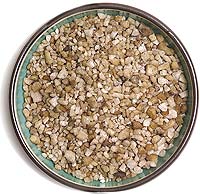
Smoked salts. Photos courtesy SaltWorks.us.
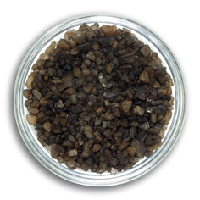
|
SODIUM CHLORIDE
The chemical compound for salt, composed of the elements sodium and chloride. The compound is sold in different sizes and forms, depending on intended use (e.g. table salt, food manufacturing).
SOUR SALT
See citric salt.
TABLE SALT or COOKING SALT or GRANULAR SALT
A refined, fine-grained salt containing additives which make it flow freely. It does not stick to food very well and when added to solutions it is slow at dissolving. Table salt is basically used for cooking and as a condiment to season foods. It is usually refined from salt found in mines. Once it is mined, it is refined and most minerals are removed from it until it is pure sodium chloride. Table salt is available in both plain and iodized forms.
|
|
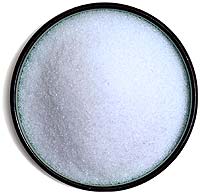
Everyday table salt. Photo courtesy SaltWorks.us. |
American salt manufacturers began iodizing salt in the 1920s, in cooperation with the government, after people in some parts of the country were found to be suffering from goiter, an enlargement of the thyroid gland caused by an easily-preventable iodine deficiency. People require less than 225 micrograms of iodine a day. Seafood, cruciferous vegetables, and sea salt contain iodine naturally and iodized salt is unnecessary if there are sufficient quantities of these items in one’s diet.
TERROIR
Pronounced tur-WAH, the French word for soil, land or terrain, “terroir” has long been used in wine and coffee analysis to denote the special characteristics of geography that give the grape or bean its individuality: soil, geology, aspect, altitude. It is an extended meaning of the word for land and can be loosely translated as “a sense of place,” the sum of the effects that the environment has on the creation of what is grown there. The same variety of grape, coffee bean, cacao bean, olive, etc. grown in the same region (as well as in different regions) can create different-tasting and different-colored oil based on the terroir of the farm, grove, and so forth. The term can also be used to describe sea salt and any other agricultural product where the flavor is significantly impacted by its surroundings.
TRAPANI
On the west coast of Sicily, the 13.7-mile stretch of coast between Trapani and Marsala is a “saltworks” that produces Fior di Sale. Historical references that date to 1154 describe the operation. The area has the perfect conditions for harvesting salt: the constant presence of winds from North Africa, which help evaporate the seawater into salt, the extremely pure seawater with a high concentration of salt and a warm, dry climate.
VERY LOW SALT
A product with 35 mg or less sodium per serving. See also low salt and salt-free.
Return To The Article Index Above
Information courtesy of SaltWorks.us, SaltInstitute.org and other sources.

|










